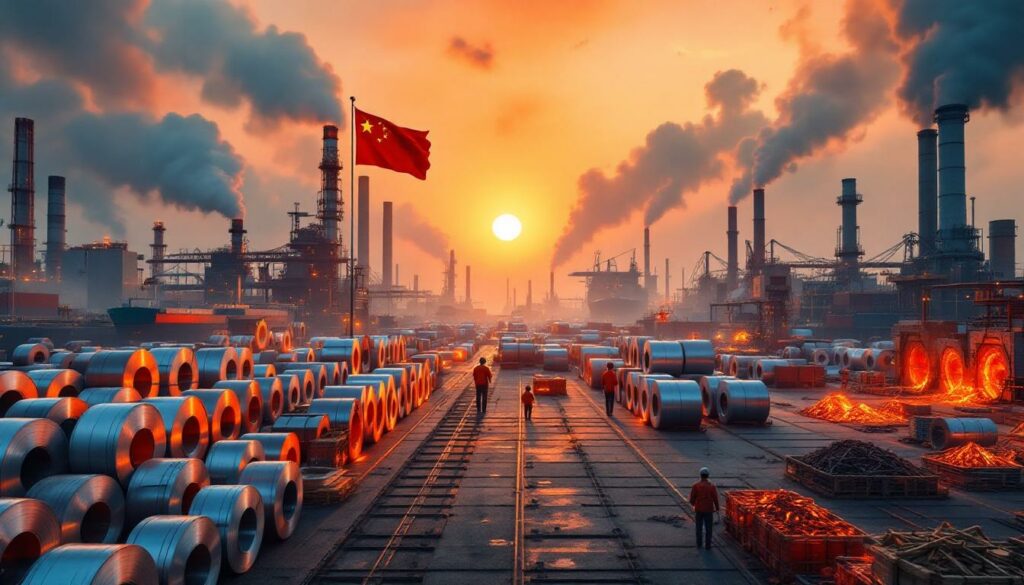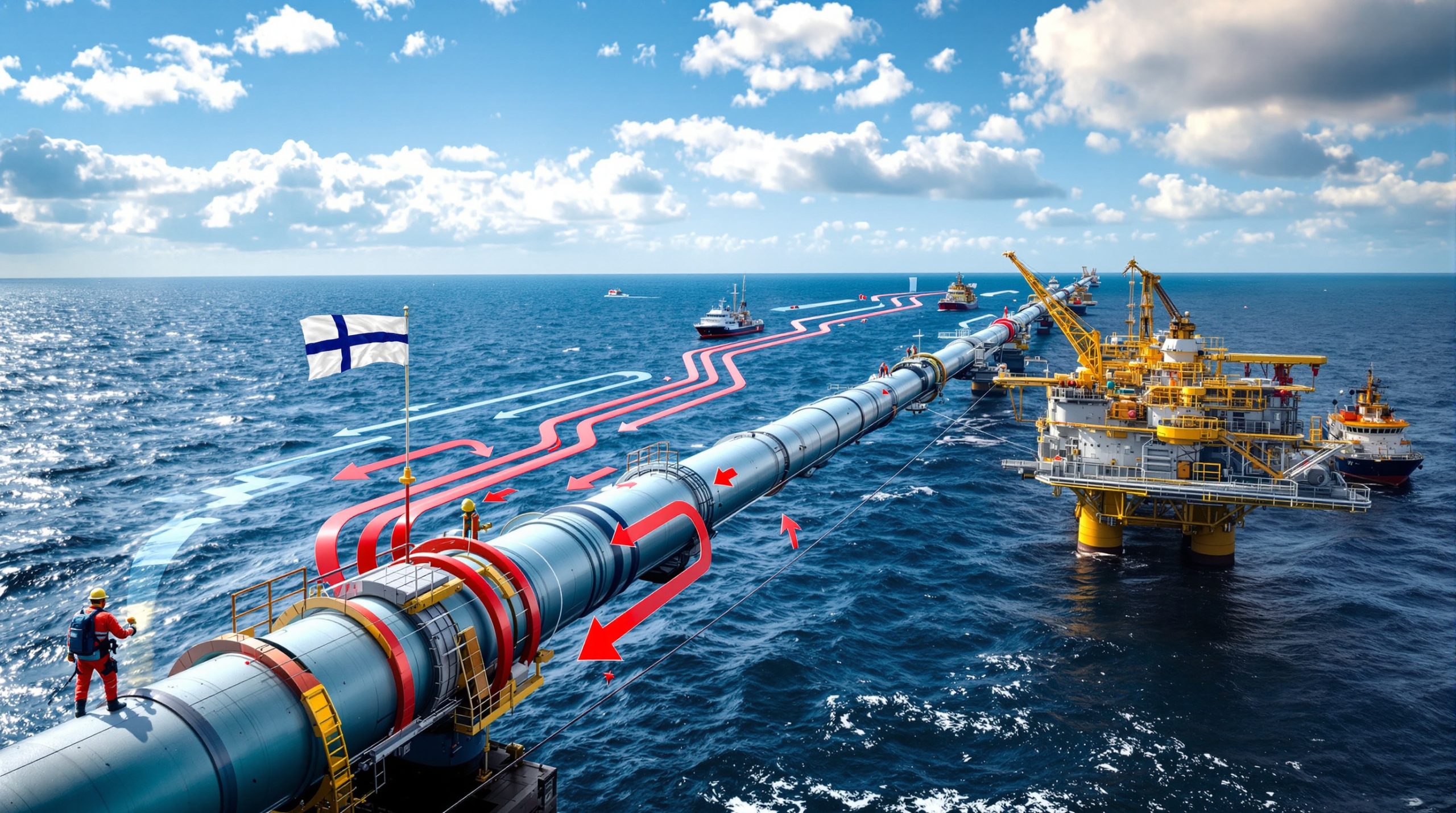China's Steelmaking Losses: Market Rebalancing on the Horizon?
China's steel industry finds itself in a precarious position – operating at losses while still dominating global supply. This complex situation stems from domestic market weakness, record-setting exports, and structural imbalances that could finally force a major industry transformation. Recent data and expert analysis suggests we may be approaching an inflection point for global steel markets, with iron ore price trends increasingly pointing toward long-term changes in the sector.
What's Causing China's Steel Industry Crisis?
The Perfect Storm of Domestic Demand Collapse
The Chinese steel sector faces unprecedented challenges as domestic demand has dramatically contracted. Hot-rolled coil (HRC) prices have plummeted to approximately $375 per tonne (excluding VAT), a level that sits well below production costs for most Chinese steelmakers. According to World Steel Dynamics' tracking of 35 major Chinese steel plants, this price point represents an unsustainable economic environment.
Philipp Englin, CEO of World Steel Dynamics, stated during the Global Steel Dynamics Forum in June 2025: "It's clear that the steel industry in China is suffering greatly." This pricing environment has created severe margin pressure, with many producers operating at significant losses simply to maintain operations and cover fixed costs.
The demand decline stems primarily from China's ongoing property sector contraction, which traditionally consumed up to 40% of the country's steel output. With real estate development stalled and infrastructure investment cooling, domestic steel consumption has entered what industry analysts describe as a "structural decline" rather than a cyclical downturn, contributing to the iron ore price decline seen in global markets.
Record-Breaking Export Surge
As domestic consumption falters, Chinese steel producers have redirected massive volumes to international markets. Exports have reached historic levels, increasing 9% above 2024's record of 124 million tonnes, which had already surpassed the previous high of 122 million tonnes set in 2015.
"We're now continuing what is a three-year trend of rising Chinese steel exports and anaemic-to-declining global steel demand," notes Englin. This flood of exports represents a desperate attempt by Chinese producers to maintain operations despite domestic market weakness.
The export surge has accelerated despite most shipments being sold at prices below production costs. Chinese mills continue this seemingly irrational behavior because:
- The alternative (idling capacity) often carries higher immediate costs
- Fixed costs can be partially covered through exports even at loss-making prices
- Market share preservation remains a strategic priority for many producers
- Local employment considerations still influence production decisions
The "Death Spiral" of Global Steel Pricing
The combination of China's export surge and weakening global demand has created what industry experts describe as a "death spiral" in international steel pricing. Current world export prices, including freight costs, have remained below production costs for an extended two-year period.
"The world export price, including freight, is at a loss-making level, resulting in what we see as a death spiral condition," explains Englin. This prolonged period of unprofitable pricing has forced producers worldwide to operate at reduced margins or losses.
The global demand picture compounds this challenge, with steel consumption outside China and India declining by 2% year-over-year. This contraction in key consumption markets creates a fundamental supply-demand imbalance that continues to pressure prices downward.
| Market Condition | Current Status | Historical Comparison |
|---|---|---|
| Chinese HRC Price | $375/tonne (ex-VAT) | Below marginal production cost |
| Chinese Steel Exports (2024) | 124 million tonnes | Exceeded 2015 record (122M tonnes) |
| Chinese Steel Exports (2025) | 9% above 2024 levels | Highest in history |
| Global Steel Demand (ex-China/India) | -2% year-over-year | Continued weakening trend |
| Duration of Below-Cost Pricing | 2+ years | Longest "death spiral" in modern industry history |
How Is This Affecting Global Steel Markets?
Widening Ripple Effects on International Producers
The sustained period of below-cost pricing has forced steel producers worldwide to reconsider their operational strategies. Many international steelmakers have been compelled to reduce output, temporarily idle facilities, or even permanently close less efficient operations.
ArcelorMittal, the world's second-largest steelmaker, announced production cuts across its European operations in early 2025, citing "unsustainable market conditions created by the flood of below-cost Chinese exports." Similar measures have been taken by producers in North America, Japan, and South Korea.
The global steel sector's financial health has deteriorated markedly, with average EBITDA margins falling to single digits for many major producers outside protected markets. This margin compression affects investment decisions, capacity utilization, and long-term strategic planning across the global steel sector.
Growing Protectionist Responses
Since 2015, there has been a notable increase in protectionist measures by steel-consuming nations seeking to shield domestic producers from Chinese exports. These trade barriers appear to be delivering results, with profitability in protected regions significantly higher than during the 2015-2016 period.
"Protectionism since 2015 appears to be working… profits in most regions are higher than in 2015-2016," observes Englin. The effectiveness of these measures has encouraged additional countries to implement or strengthen their trade defenses, with tariff impact analysis showing mixed but generally positive outcomes for protected industries.
Recent protectionist actions include:
- The European Union's extension and expansion of safeguard measures
- India's implementation of additional quality control requirements
- Southeast Asian nations introducing stricter import licensing systems
- Middle Eastern countries establishing minimum import price mechanisms
Industry consensus suggests additional protective measures are likely in the near future. Englin notes that "a consensus among most folks is emerging that additional measures will be taken, need to be taken, and depending on the path that industry sets for itself, will be taken."
Investment Hesitancy and Supply Constraints
The current pricing environment has created strong disincentives for capacity expansion in the global steel industry. Major producers have delayed or canceled planned investments, focusing instead on modernizing existing assets or shifting toward higher-value specialty products.
"I'm an optimist, in the sense that investment incentives will act to limit the pace and extent of any expansions of supply, helping rebalance the industry on a more sustainable path," explains Englin. This investment reluctance may ultimately help rebalance the market by limiting supply growth.
The hesitation extends beyond traditional steelmaking into adjacent sectors. Mining companies have scaled back iron ore expansion projects, while equipment manufacturers report declining orders for new steelmaking machinery. This ecosystem-wide response suggests a comprehensive retrenchment that could eventually restore market balance.
Why Might China Reduce Steel Production?
Learning from the Property Sector Intervention
China has demonstrated willingness to address structural imbalances, as evidenced by its decisive action in the property sector beginning in 2020. By restricting financing to major developers, China effectively burst its real estate bubble, accepting approximately $500 billion in banking losses to achieve long-term market stability.
This precedent suggests similar intervention could occur in the steel sector. "China's property sector intervention offers a model: private companies absorbed losses while state entities stabilized," notes Englin. The government's willingness to accept short-term pain for long-term stability indicates it may apply similar principles to steel.
The property sector experience demonstrates China's capacity for strategic restructuring when excess capacity threatens economic stability. The government allowed major developers like Evergrande and Kaisa Group to collapse rather than continue perpetuating market distortions. A similar approach to steelmaking could significantly reshape global markets, as analyzed in China's steel production cuts.
Public vs. Private Sector Dynamics
With 30-40% of Chinese steel production controlled by private entrepreneurs, the government has potential leverage to consolidate and rightsize the industry. This could mirror the property sector experience, where private companies bore the brunt of adjustment while state-owned enterprises maintained greater stability.
"It certainly gives me optimism in the next handful of years that the oversupply situation in the Chinese steel market may ultimately be addressed… in a way that may very well resemble the property sector experience, where in many ways the private sector was squeezed at the expense of the public sector."
— Philipp Englin, CEO, World Steel Dynamics
This public-private divide creates natural leverage points for government-directed restructuring. Private mills typically operate with thinner financial reserves and less political protection than their state-owned counterparts, making them more vulnerable to regulatory pressure or financing restrictions.
Such restructuring could significantly reduce China's steelmaking footprint while preserving strategic capacity within state-owned enterprises. The government could achieve this through various mechanisms:
- Stricter environmental enforcement targeting older, private facilities
- Selective credit tightening for privately-owned steel operations
- Consolidation incentives favoring state-owned enterprises
- Differential energy pricing or raw material access
Demographic Pressures Creating New Incentives
China faces a projected decline of 50 million working-age individuals over the next five years. This demographic shift reduces the political imperative to maintain steel production solely for employment purposes.
"The need to maintain steel production for employment lessens with a 50-million decline in working-age population," explains Englin. This demographic reality creates policy space for capacity rationalization that might previously have been politically unacceptable.
The aging workforce in the steel sector creates a natural opportunity for capacity reduction through retirement attrition rather than disruptive layoffs. Many Chinese steel facilities, particularly those built during the early 2000s expansion boom, now employ workers approaching retirement age. This demographic profile enables a more gradual and politically palatable downsizing strategy.
What Role Will Scrap Steel Play in China's Transition?
The Growing Domestic Scrap Reservoir
China's maturing economy is generating an increasingly substantial reservoir of recyclable steel. After decades of intensive construction and manufacturing, the country now possesses a growing inventory of steel-containing assets reaching end-of-life status.
Englin highlights that China's reservoir of scrap steel will experience a "massive increase in the coming decades, providing another key incentive to both downsize and ultimately alter the landscape of the country's steel sector." This expanding scrap supply creates both opportunity and pressure to transition steelmaking methods.
The scrap reservoir growth derives from several sources:
- Building demolitions as urban renewal accelerates
- Vehicle retirements as the automotive fleet matures
- Industrial equipment replacement cycles
- Infrastructure rehabilitation projects
This domestic scrap availability reduces China's strategic need to maintain blast furnace capacity at current levels, as more of its steel requirements can be met through recycling rather than primary production.
Economic Advantages of EAF Technology
Electric arc furnaces offer several advantages over traditional blast furnaces, including greater flexibility, lower capital requirements, and potentially higher profitability. These economic incentives could drive a market-led transformation of China's steel sector as part of broader industry evolution trends.
"As China replaces blast furnaces with electric-arc furnaces (EAFs), private entrepreneurs will likely be motivated to invest in EAF mills because they are more profitable and, in the process, reduce overall capacity in the nation as a result," notes Englin.
EAF technology provides superior economics through several mechanisms:
- Lower fixed costs allow more flexible production scheduling
- Reduced energy consumption per ton of steel produced
- Smaller minimum efficient scale enables targeted regional production
- Faster startup/shutdown capabilities improve market responsiveness
- Lower capital intensity improves return on investment metrics
Private entrepreneurs within China's steel sector may find economic incentives to invest in EAF technology while simultaneously reducing overall capacity, creating a market-driven path to industry restructuring.
Environmental Benefits Aligning with Policy Goals
The transition toward greater scrap utilization through EAF technology aligns with China's stated environmental objectives. Steel production accounts for approximately 15% of China's carbon emissions, making it a critical sector for achieving the country's carbon neutrality targets through the broader mining decarbonisation shift.
EAF technology offers significant environmental advantages:
- Up to 75% lower carbon emissions per ton versus blast furnaces
- Reduced particulate matter and other air pollutants
- Elimination of coking coal requirements
- Lower water consumption and wastewater discharge
- Smaller physical footprint and land use requirements
This technological shift could reduce carbon emissions while maintaining sufficient production capacity to meet domestic needs, potentially making it an attractive policy direction for Chinese authorities seeking to balance economic and environmental objectives.
How Might Global Steel Markets Rebalance?
The Effectiveness of Trade Protection Measures
The implementation of tariffs, quotas, and other trade barriers since 2015 appears to be yielding positive results for protected markets. Profitability in regions with strong trade defenses has significantly improved compared to the 2015-2016 period.
This trend suggests continued or expanded protectionism may help stabilize markets outside China. Trade measures have created price differentials between protected and unprotected regions, with protected markets maintaining steel prices 15-25% above global export levels in many cases.
The effectiveness of these measures has varied by region:
- North America: Section 232 tariffs and quotas have maintained substantial price premiums
- European Union: Safeguard measures have provided moderate protection but face circumvention challenges
- India: Comprehensive quality control requirements have effectively limited Chinese imports
- Southeast Asia: Variable effectiveness, with stronger results in countries with stricter enforcement
The continuation and potential strengthening of these protective measures represents one pathway toward market rebalancing, though it carries risks of trade diversion and economic inefficiency.
Investment Discipline as a Balancing Mechanism
Current market conditions have created strong disincentives for capacity expansion, which may ultimately help rebalance the global supply-demand equation. As investors remain cautious about committing capital to new steelmaking facilities, supply growth constraints could eventually lead to improved pricing power for existing producers.
This investment discipline extends across the value chain:
- Steelmakers deferring new plant construction
- Existing facilities focusing on maintenance rather than expansion
- Mining companies reducing capital expenditures for new iron ore capacity
- Equipment manufacturers scaling back production of steelmaking machinery
Over time, this investment restraint combined with normal capacity attrition through aging could gradually tighten the supply-demand balance. As Englin notes, "investment incentives will act to limit the pace and extent of any expansions of supply, helping rebalance the industry on a more sustainable path."
China's Potential Capacity Reduction
If China follows through with meaningful capacity reductions, similar to its approach in the property sector, global steel markets could experience significant rebalancing. A smaller Chinese steel footprint would reduce export pressure while potentially allowing domestic prices to recover to sustainable levels.
The capacity reduction could occur through several mechanisms:
- Forced closures of older, less efficient facilities
- Financing restrictions for private steelmakers
- Consolidation of fragmented producers
- Natural attrition through retirement and limited reinvestment
- Technology transition from blast furnaces to EAFs
Industry analysts suggest a reduction of 100-150 million tonnes of Chinese steelmaking capacity would likely be sufficient to rebalance global markets. This represents approximately 10-15% of China's current capacity but would significantly reduce the export volumes currently disrupting international markets.
What Are the Implications for Steel Industry Stakeholders?
For Steel Producers
Steel companies must navigate a challenging period of below-cost pricing while positioning themselves for eventual market recovery. Producers outside China face difficult strategic choices regarding capacity utilization, cost control, and potential consolidation.
Key considerations for steel producers include:
- Optimizing production to focus on higher-margin products
- Accelerating cost reduction initiatives across operations
- Evaluating strategic consolidation opportunities
- Investing selectively in technologies that reduce carbon intensity
- Developing stronger relationships with downstream customers
- Advocating for appropriate trade protection measures
Producers in protected markets may fare better than those directly exposed to Chinese exports. Companies with diversified geographical footprints can leverage regional price differentials, while specialty producers may maintain better margins than commodity steel manufacturers.
For Steel Consumers
Downstream industries benefiting from artificially low steel prices should prepare for potential market rebalancing that could lead to higher input costs. While the timing remains uncertain, structural changes in China's steel industry could trigger relatively rapid price normalization.
Prudent preparation strategies include:
- Developing diverse supplier relationships across multiple regions
- Considering longer-term supply agreements to hedge against price volatility
- Exploring design modifications to optimize material utilization
- Implementing steel price escalation clauses in customer contracts
- Monitoring policy developments in key steel-producing regions
Industries with high steel intensity, such as automotive, construction, and machinery manufacturing, should be particularly attentive to signs of market rebalancing that could affect their cost structures.
For Investors and Financial Stakeholders
The steel sector presents both risks and opportunities for investors. While near-term profitability challenges persist, companies well-positioned for an eventual market rebalancing could offer significant upside potential.
Investment considerations include:
- Differentiating between structurally advantaged and disadvantaged producers
- Evaluating regional exposure and trade protection benefits
- Assessing technological positioning, particularly regarding decarbonization
- Analyzing balance sheet strength to weather continued market pressures
- Monitoring Chinese policy signals regarding capacity rationalization
Understanding the timing and magnitude of China's potential capacity reduction will be crucial for investment decisions. Early identification of
Ready to Stay Ahead of Major Mining Discoveries?
Discover why ASX mineral discoveries can lead to significant market returns by exploring Discovery Alert's dedicated discoveries page, powered by the proprietary Discovery IQ model that turns complex mineral data into actionable insights for investors seeking immediate trading advantages.




